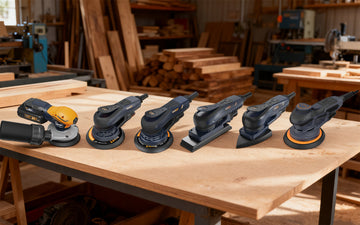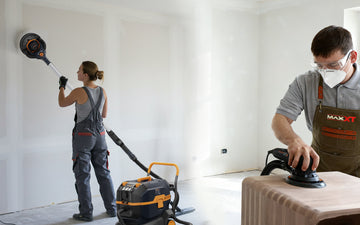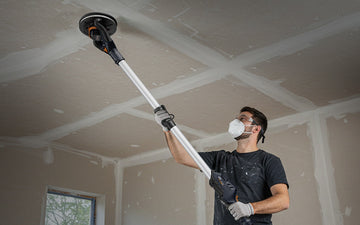Sanders comprise a diverse array of products designed for specific purposes, and are aimed at improving efficiency. Different sander types are widely used across industries, with specific applications in the automotive, woodworking, and construction sectors.
This guide provides an overview of different kinds of sanders and their applications, enabling buyers to make informed purchasing decisions when sourcing products from leading power tool manufacturers like Hyperfit.
Belt Sanders
Belt sanders use a powerful electric motor to rapidly rotate a continuous loop of abrasive sandpaper, called a sanding belt, around two drums. Their long, wide sanding belts can quickly remove material from large, flat surfaces, making them a go-to option for large-scale projects that require speed and efficiency.
Belt sanders are versatile tools. They come in compact handheld versions as well as fitted to a working bench, or large free-standing models.
Best Uses
These tools operate as surface prep sanders for heavy-duty sanding tasks, such as:
● Removing a lot of material fast with a coarse sanding belt
● Sanding floors
● Desk resurfacing
● Smoothing rough wood, metal, or plastic edges quickly
● Removing polyurethane sealants and stains, paint, and sun damage from wood
● Sharpening tools like knives and chisels
Pros
● Remove a lot of material in a short time if used with a coarse grit sanding belt.
● Improve productivity for large tasks.
Cons
● Not suited to delicate projects – if not operated skillfully, a belt sander can damage material considerably
● Generate a significant amount of dust, requiring safety gear when in use
Orbital Sanders (Sheet Sanders)
Orbital sanders work with a circular or square sanding pad that moves in a gentle, consistent circular movement, making it ideal for sanding tasks that don't require heavy sanding. The tool is popular with veteran DIYers but it's also suitable for beginners since they are lightweight and easy to use.
Best Uses
● Light sanding tasks – wood, edges and corners
● Finishing surfaces in preparation for painting or staining
Pros
● Produce a fine finish
Cons
● The small circular movements of the pad at high speed can leave swirl marks
Random Orbital Sanders
The simple circular motion of the orbital sander, which can lead to swirl marks, has led to the development of the random orbital sander. With this sander, the sanding pad still orbits in a circular motion, but it also oscillates in a random pattern. The combined effect is a smooth finish without any swirl marks.
Best Uses
● Automotive and metal finishing
● General woodworking
● Construction and remodeling
Pros
● Extremely versatile – can be used rough sanding and fine sanding across many surfaces
● Minimize swirl marks, producing superior finishes
Cons
● Can't be used in tight corners
● Require considerable skill to operate – if it's not in constant movement or too much pressure is applied, it can result in an uneven surface or burn marks in the surface
Detail Sanders (Mouse Sanders)
Detail sanders are designed for precision work. A detail sander is a small tool that uses a rapid oscillating or orbital motion and small (usually a triangular-shaped) pad to reach tight corners on elaborate surfaces and objects
Best Uses
● Removing old paint, varnish, or stains from old furniture or built-in cabinets
● Stripping intricate moldings, such as dado rails, cornices, and wainscoting
● Enabling meticulous surface preparation for planned repainting or staining of delicate objects
● Smoothing interior vinyl, plastic, or metal surfaces of vehicles
Pros
● Compact and easy to operate, so they are ideal for beginners
● Can handle precision work
● Can sand in areas that larger, more powerful sanders can't reach
Cons
● Only suitable for sanding small areas and fine-detail work
Disc Sanders
Disc sanders are usually mounted on a workbench. A disc sander consists of a round sanding disk mounted vertically, powered by an electric motor.
Best Uses
● Excellent for shaping, and finishing large wood, metal, and plastic surfaces
● Ideal for smoothing large, uneven surfaces, irregular shapes, and edges
● Tailor-made for heavy-duty material removal when fitted with coarse discs
Pros
● Deliver accurate results
● Deliver diverse results: rough and fine finishing
Cons
● Can easily overheat and damage materials
● Generate significant amounts of dust, which require safety gear to prevent dust inhalation
Drum Sanders
A drum sander is a powerful sanding machine that consists of a cylindrical drum wrapped with sandpaper. The drum rotates at high speed, removing material evenly across large, flat surfaces.
There are two kinds: stationary drum sanders and walk-behind drum sanders. The stationary sander is used in professional workshops or manufacturing to sand large surfaces. Walk-behind sanders are used to sand floors.
Best Uses
● Sanding hardwood floors
● Processing wide boards or panels quickly and evenly
● Smoothing butcher blocks and countertops
● Leveling and finishing wood for cabinetmaking and furniture production
● Leveling laminated tabletops and other large laminated surfaces
● Stripping old finishes like paint, varnish, or lacquer from large wooden surfaces
Pros
● Versatile tool that can do both heavy material removal and fine finishing
● Excellent for sanding large, flat surfaces quickly and evenly
Cons
● Require considerable skill to prevent damage to materials
● Generate significant dust, so dust collection systems are essential
Spindle Sanders (Oscillating Sanders)
Spindle sanders are specialized sander type that feature a cylindrical sanding drum (spindle) that oscillates up and down while spinning. The oscillating movement minimizes the risk of friction, preventing burn marks and ensuring a smooth surface.
Best Uses
● Sanding curves, rounded edges, and irregular shapes
● Precision woodworking tool for furniture making
Pros
● Excellent tool for woodworking
● Excellent at smoothing curved and intricate shapes
● The oscillating action prevents the sandpaper from wearing out quickly
Cons
● Can't be used for sanding large flat surfaces
● Can't remove large amounts of material
Drywall Sanders
Drywall sanders are specialized tools designed to smooth drywall joints and ceilings. They come with a round or rectangular sanding pad fitted onto a long pole. Sanding drywall creates significant dust, so these tools come with integrated dust-collecting systems.
Best Uses
● Smoothing joint compound and filler, ensuring an even surface for paint or wallpaper
● Smoothing drywall and ceilings in new constructions and renovations
Pros
● The only tools that can smooth drywall professionally
● Saves time and minimize dust with integrated dust extraction
Cons
● Can be heavy and tiring to use for extended periods
● Can't replace manual sanding in tight corners
Safety Considerations
Operating sanders requires skill and attention to personal safety. Most of these tools remove material quickly and must be operated with care to avoid injuries, dust inhalation and damage to sanding equipment.
Basic Safety Guidelines and Protective Measures When Using Sanders
● Wear protective gear, including safety goggles, a dust mask or respirator, and hearing protection.
● Avoid loose clothing, tie long hair back, and remove jewelry that a moving machine can catch onto.
● Pay attention to dust control. Connect the sanding tool to a dust bag or external vacuum system to minimize airborne particles.
● Before every use, inspect all components, including power cords, plugs, and switches to ensure they are in good working condition.
● For tools fitted to a workbench, clamp or otherwise secure the material to prevent movement during sanding, which can lead to injuries; for handheld tools, hold the sander firmly, preferably with both hands.
● Pay attention to the pressure application – don't use excessive force, it's unnecessary. Guide the tool and let it do the work. Excessive force can damage the tool and the material, or it can lead to kickback and potential injury.
● Work in a properly ventilated area to prevent dust inhalation.
● After every use, turn off and unplug the sander. Do the same before changing discs, pads, or sanding sleeves.
FAQs
How can I make sure my sander works for many years?
Perform regular maintenance by cleaning the dust collection system after every use, checking and replacing the sanding pad regularly, and inspecting all cords and moving parts regularly, replacing them when necessary.
Can I use the same sander for both heavy material removal and fine finishing?
It depends on the sander. A versatile sander, like a random orbital sander, can be fitted with different grits for diverse tasks, but a specialized tool, such as a detail sander, is only suitable for fine finishing.
How do I choose the right grit size for a sanding project?
Choose a coarse grit (40–80) for rapid material removal, medium grit (100–150) for smoothing, and fine grit (180–240+) for finishing. For example, you can start with 80 grit to remove old paint from a coffee table, move to 120 grit to smooth the surface, and finish with 220 grit before staining it.
In what direction should I sand?
Always sand with the grain to avoid scratches and uneven texture.
Which sander is best for beginners?An orbital sander is the best choice for this purpose. They are lightweight and easy to use on numerous surfaces.
Conclusion
Choosing the right sander type is essential to ensure professional results in workshops, on construction sites, and in manufacturing. Each of the eight sanders covered in the guide has unique strengths, specific features, and ideal applications. Understanding these sander type differences is the first step toward choosing the right tool for a project and its successful completion.
If you are planning a project that involves sanding, consider purchasing a high-quality tool from the Hyperfit range of power tools. We have specialized sander types that will speed up your work and ensure a quality finish.
Explore the Hyperfit range of precision tools and contact our team today for expert advice so you can tackle your next project with confidence.







